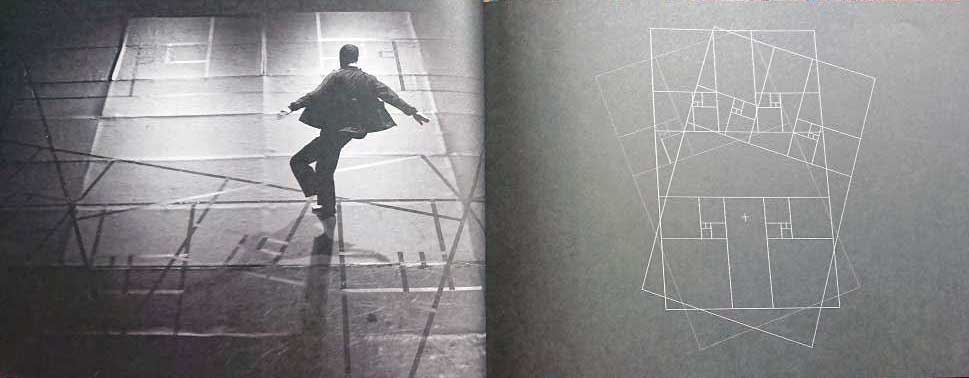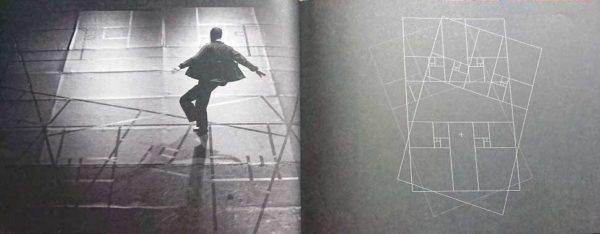
“You can’t dance beyond gravity, but you can relate to it. You can consider it not only as something that limits us but also as something that defines us. You can dance with it …” (Keersmaeker in the accompanying book of A Love Supreme, 2019 or in slightly different wording here)
The ticket, a gift by a friend, located me perfectly on the first balcony center position. I barely sit in such an overview position, often rather prefer to experience the immediate proximity of the stage or area of performance from the first row. Depending on the theater one nowadays often gets in an accurate percentage number how much one still will perceive. But this time I saw it all just from slightly above. The HAU 1 is an elder small and cozy theater, so some proximity still given even from the balcony. There was no curtain the stage bare in its blackness built from different shades of dark grey. Just having made it last minute I starred down into it. Registering the black painted wall of bricks, pipes and tubes I thought to myself that while the stage in its rawness, that probably becomes more accentuated in such a classical theater space as the HAU 1 is, not at all is an unfamiliar view anymore, however not too many use it. The darkish dance floor had a lot of small tapelines in different shades of dark grey and black. “Is the floor that old?”, I discarded that idea and thought it cannot be, but rather may hint at the things to come. And as that was “A Love Supreme” I forgot about this thought until I wanted to leave the theater. But more to that later.
The dance started in silence – or better without music. Four male dancers, one with a jacket, accessing the space and formulating their gestures. As all being dressed relatively dark their bare arms, hands, feet and head were accentuated. I cannot anymore describe all their movements (and more so won’t try as there are perfect descriptions already out there ), but I recall the accentuation on gesture. A particular focus on body extensions: arm gestures, straightened out hands, body rotations resolved into another move, a twist with the heel, a singularity that more often than not fell into rhythm with similar movements of the others. Then pause – the same guy now without the jacket, Thomas Vantuycom, returns, seems searching, may be probing and testing moves on his own. Interrupted, irritated – will he find a flow? Can at all “A Love Supreme” be danced? Will it not be pure illustration?
I was irritated after I discovered that each of the four dancers obviously was to embody one of the instruments (José Paulo dos Santos (for the drums, Elvin Jones on the recording), Jason Respilieux (Jimmy Garrison on bass), Robin Haghi (McCoy Tyner on piano) and T. Vantuycom (Coltrane on tenor sax). Wasn’t that too formalist? However it worked: the ‘instruments’ overlapped, took over from each other, complemented what just had been heard/show’. In fact as I reading in the accompanying book the strongly structural parts, the phrases each dancer repeats or joins in with the others are interrupted by improvisation. For the onlooker this is not really distinguishable, but the impression of pure Keersmaeker formalism is deteriorated by the inventiveness, energy and interplay of the four dancers. Salva Sanchis stated in an interview that for him “the structure of Coltrane’s “A Love Supreme†is classical in form, […] “There is a basic melody done over a progression of chords that is played once or twice at the beginning of each song. Then the musical improvisation begins. I created a phrase for each basic melody, then the dancers improvise when the musicians do, always referring to the original set phrase.â€
The falling in and out of sync of the dancers seems to be more complex than usually. The immediate reaction of improvisation may explain this. But is it improvisation if the music is each time played from the same recording? Doesn’t this foster a creation of habitual moves for the dancers?
De Keersmaeker states that in her research for the piece she came across the fact that in “non-Western music, composition and improvisation are not mutually distinct concepts. Indeed, improvisation is composition in the immediacy of the moment.†And she talks about the amount of possibilities she has to decide from as a dancer, and movements that ones does and those which happen to you – which move one. Some expressions can only be gained in a physical event with their own values. May this be exhaustion or getting off balance an into again – there “is a kind of fullness one couldn’t experience otherwise. Dichotomies like rational versus intuitive don’t do justice to reality.” (S. Sanchis). After all also musicians have their phrases on which they come together after going meandering through their solo pieces.

image from the book “A Love Supreme”, 2019
And what was then floor pattern about? The reason why I took the book home with me from the event, was that I discovered an image in there and on the next page the headline “The Infinite Possibilities of Coltrane’s Magic Square”. Indeed there is a pattern/structure of four in Coltrane’s famous “A Love Supreme”. To read this ‘magic square’ through Dürer’s in melancholia, as Stefan Hertmans does in the mentioned essay, may however be an European appropriation and only one of multiple still open possibilities.
